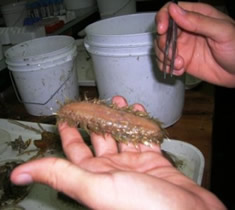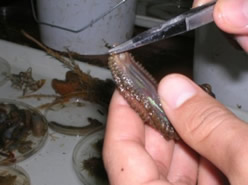The ship is back in the Bransfield Strait, and the waters are
calmer. Yesterday, we were actually in the western waters of the Drake,
and I’ll tell you, the Drake is still an angry place. Thanks for
rekindling the memories, but, no thanks.
We are traveling somewhere south of St. George Island (yes, we’ve gone
north from where we were a couple of days ago - all part of The Plan), but
between snow showers were able to see the coast of Antarctica today. You
can tell it’s The Continent because…. well, actually you can’t tell it from
most of the other landscape here, but the chart says that’s what we’re
seeing when we look east. It does make you pause to know what you’re
looking at.
There were some delays due to equipment today. That should come as no
surprise, given the climate these huge instruments are relegated to work in
down here. A spotlight froze up the light worked, but the hydraulics that
allow it to scan had seized from the freezing rain and spray. Same with a
winch lead, and a cable block as well. The MT’s and winch technicians are
looking at the mechanics of their equipment throughout an operation. If
they see something not turning that should, operations are suspended until
things are running smoothly again there is no fury like that of a large
cable under great tension (oh, well, maybe that of a woman scorned, but
that’s not happening down here). Except for Paul Waters’ climbing the
platform on top of the Bridge in wind and freezing rain to free the
spotlight, resolve was relatively simple and it was well placed force that
freed things up (like, whack the thing with another thing that won’t do the
first thing any damage). But the real query is about the occurrences being
unexpected at current temperatures, just below freezing - perfect
conditions for snags, it seems. The Captain said he had never seen rain
down here before. “It doesn’t rain in Antarctica.” Weather goes from no
snow to snow, but not the ‘in between’ that we’re seeing this year -
dampness and somewhat cold in combination seems to make the equipment
complain. The crew is well-equipped to make things work when they cease
to, that is the blessed talent of this ship’s team. There is no frenzy, no
yelling, no wringing of hands (maybe a little gnashing of teeth,
however) a thing stops, it gets some attention, and then it works
again. We can’t do anything about the weather, we can only be more
vigilant about how it might affect operations.
This evening’s plankton tow brought in a great deal of krill. It was
difficult sorting plankton with the quantity and physical size of these
crustaceans, but that’s where the sieving comes in. More valuable samples
were found despite the preliminary inconvenience. Another piece of the
krill scenario was the presence of crab eater seals following the
net. They dove and surfaced with the net. Why chase krill if they’re crab
eaters??? Now, I’m not a linguist, and I don’t have access to Google here,
but I was told over dinner that it’s actually a derivation of the German
name for these seals. Tell me if I’m wrong, but the German word for “krill” is close in sound to our word “crab”, and the English-speaking
piniped namers just borrowed the sound, not the meaning of the word in the
name for these seals. It makes perfect sense to me, since I was just told
(unrelated to the seal conversation) that they rarely see crabs in
Antarctica. There are occasional spider crabs, but there would not be a
population that would be the food source for seals with the prevalence of
crab eaters. With so many krill, there will likely be other mammals
feeding I wonder if the whales are watching us sail by tonight.
The benthic tow was equally productive. It is the best array of diversity
I have yet seen. Among the trays of critters being sorted were many types
of worms, crinoids (related to sea stars), sea spiders (the largest I’ve
seen in 2 trips down here), several of a white variety of sea slugs
(nudibranchs), very large sea cockroaches (isopods), sea mice (annelid
worms with hair, segmented like earthworms, only UGH-leeee!!), many sea
cucumbers and sea squirts, and a huge sea anemone that, when cut open, had
a whole sea mouse in its mouth (even Ugh-lier). Jon Craft showed me a true
shrimp they’d captured that was very rare in Antarctic waters. This was a
fun-to-observe trawl.
Getting to Know You
Diego Giberto, Argentine Observer
My name is Diego Giberto. I work at the benthos laboratory of the
National Institute for Fisheries Research (INDEP) of Argentina. My main
interest is the understanding of ecological processes that control
biological diversity in frontal areas, e.g. predation, niche partitioning,
dispersion and tolerance to environmental gradients. Marine and estuarine
frontal areas are important because, among other characteristics, they
usually have high values of biological production, they constitute major
foraging grounds for nektonic organisms, and they could promote larval
retention, with the consequence that they affect the biological patterns of
surrounding waters.
I have a fellowship through CONICET (The National Council for
Scientific and Technological Research of Argentina) to complete my PhD in
Biological Sciences at the National University of El Comahue. My advisors
are Dr. C. Bremec and M. Acha. The research topic is the trophic ecology of
seven species of benthophagous fishes of the Rio de la Plata estuary,
Argentina-Uruguay, which is characterized by the presence of two salinity
fronts. I study both the diet (gut contents, habitat use and morphology)
and the availability of potential prey in the benthic communities
(abundance and biomass patterns, diversity and habitat use). Recently I
also started to explore the potential effects of an exotic species (a
predatory gastropod) in the local benthic communities and the food webs of
the estuary.
I am on this research cruise invited by the USAP, due to the fact that part
of their work is in Argentinean waters, and I am representing my country as
a Scientific Observer. Since I am a benthic ecologist I am helping with
benthic sampling and sorting of the target species, in particular,
polychaetes. The personal contact and collaboration with experimental
scientists and students from different countries is providing me the
possibility to update and exchange scientific information regarding frontal
areas, larval dispersion and invertebrate biology, which will be very
useful not only from a personal point of view, but also to the institutions
which I represent.
Don't hesitate to email
questions to us at outreach@lmg.usap.gov
|
|
Longitude/Latitude:
S62° 39.724’ W58° 00.101’
Temperature:
Wind: NW 8.4kn
Air Temp: -0.3°C
Wind Chill: -6.2°C
Surface Water Temp: -1.589°C
Menu:
Roast Chicken, pork chops, spinach, rice, salad, lemon cake,
carrot bread; Tortellini casserole, quiche, veg lasagna, brussels sprouts,
spinach, rice, salad, whatever cake we didn't eat since lunch, and cookies.
Photos:

The Antarctic Continent, hazy backdrop to a stegasauric
iceberg]
[Photo by Janis Umschlag]

“Sea Mouse” a type of worm, quite large in Antarctic waters.]
[Photo by Ellen Bailey]

Also large, “Sea Cockroach” (Isopod) on the arm of Diego Giberto]
[Photo by Ellen Bailey]

Diego Giberto, Argentine Observer

Iceberg in Bransfield Strait today
[Photo by Pam Polloni]

“Cousin It” net, waiting its turn, in the aquarium room.]
[Photo by Ellen Bailey]

More from the Ann’lids [sic Addams] Family; Diego coaxing
it to bite.]
[Photo by Ellen Bailey]
|




